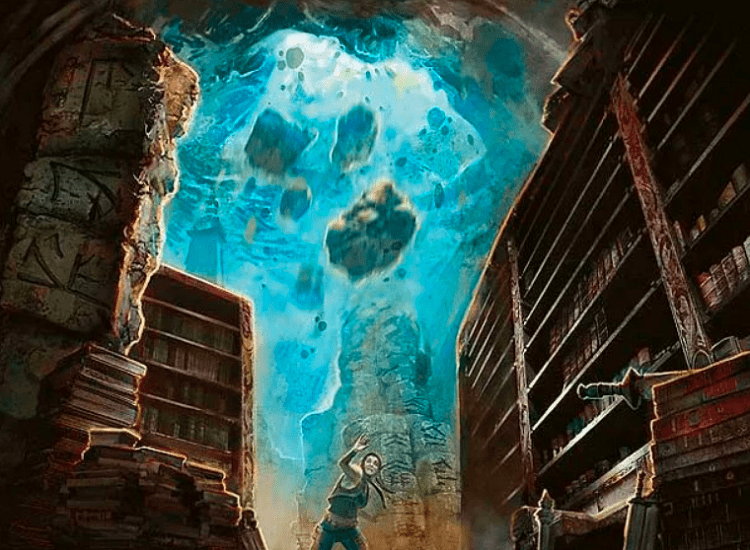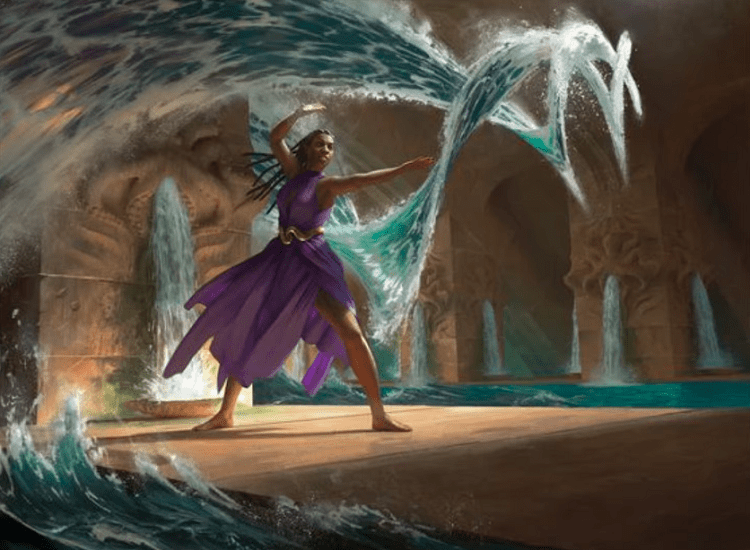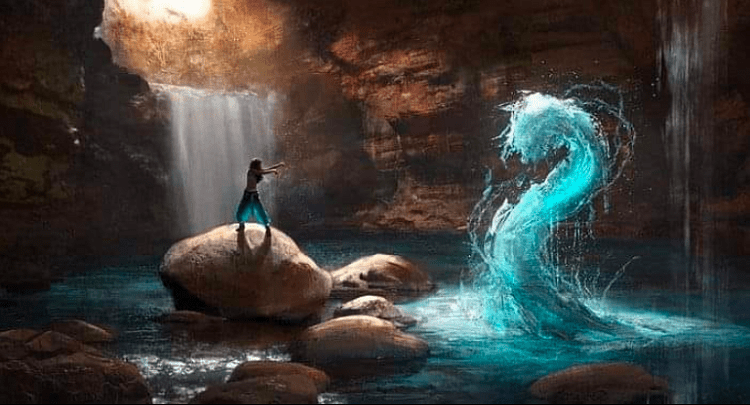Your party is tasked to go to the southern water tribe and retrieve a powerful magic item. The ruler of this land has it, and you have a note from your king asking for it. You arrive at the tribe in a canoe moved by the hands of very skilled sorceresses, who push the water, making the boat go at an alarming speed.
You pass the ice walls separating the sea from the inner canal and enter the city. The white, snowy houses are beautiful, and the people seem to be a combination of sea elves, tritons, and water genasi, with some humans here and there.
You see a pair of workers fixing some house’s walls using magic to hold water in its place until it gets frozen. It seems like everyone here has a connection with water.
As you reach the main palace and get inside, a guard escort takes you to the main hall. Sat on the throne, you see a bulky water genasi staring at you with a cold gaze. His voice sounds calm and imponent, asking the reason for our visit.
You hand over your king’s note, and the genasi smiles. “Your king is very trusty of you” -says the water king- “He knows very well the price of such an item… You need to pass the test of force.”
Suddenly, the icy ground trembles, and you all fall inside a tunnel that takes you to the cold string beneath the palace. The ruler’s voice fading in the distance says, “Find your way back, and the item is yours.” A guard reaches his king and says, “Sir, they do not know any water control.” The king replies, “They better learn it soon, then.”
Welcome to a Shape Water 5e Guide.
“Shape Water”: Much more than You Think
Before we get into the meat of this DnD spell, let me tell you why this cantrip is so good. It is not as versatile as Minor Illusion or as powerful as Eldritch Blast, but it’s probably the funniest of the three.
If you love Avatar as much as I do, this is a clear invitation to play a Waterbender. But this spell alone can infuse your character with such a unique personality that your role-play would be off the charts.
One short parenthesis. I’ll try to keep my references to the Avatar’s (The Last Airbender) World to a minimum, but if you haven’t watched the show, please do. It’s the best. Also, by watching it, you’ll see many fun quirks you can do with this spell—end of the plug.
This cantrip is helpful almost in all situations. Even if there’s no source of water nearby, keep a small bag of water with you can be enough to use it. Let’s go deeper and see what this cantrip holds under the surface.
How does Shape Water Work?

“Shape Water” is a cantrip or a 0-level spell. The casting time is 1 action, the range is 30 feet with a 5 feet cube form, the component is just somatic, and the duration is instantaneous or 1 hour, depending on the effect. The school is transmutation, and the effect is as follows:
“You choose an area of water that you can see within range and that fits within a 5-foot cube. You manipulate it in one of the following ways:
- You instantaneously move or otherwise change the flow of the water as you direct, up to 5 feet in any direction. This movement doesn’t have enough force to cause damage.
- You cause the water to form into simple shapes and animate at your direction. This change lasts for 1 hour.
- You change the water’s color or opacity. The water must be changed in the same way throughout. This change lasts for 1 hour.
- You freeze the water, provided that there are no creatures in it. The water unfreezes in 1 hour.
If you cast this spell multiple times, you can have no more than two of its non-instantaneous effects active at a time, and you can dismiss such an effect as an action.”
Breaking Down the Spell
- “Shape Water” is a cantrip, meaning two things. First, the caster knows it very well and can cast it at will. Second, it’s ingrained in the caster. What do I mean by “ingrained?” The ability to move water is natural for them. It’s a power that is part of them, no matter how they do it. A caster that uses shape water probably has some connection to the sea or the plane of water. This is important to consider for role-playing and to improve your and your friend’s game experiences.
- The Standard 1 action is unremarkable, but it’s good to keep it in mind if you want to use more than one of its effects simultaneously. You’ll need a turn to cast each of them, so no combinations in one turn (Unless you use something like “quickened spell”).
- The range is short, but you won’t need it to be longer most of the time. This cantrip doesn’t have many applications in combat; outside of it, distances are “blurry,” so you’ll be able to use it almost constantly.
- A 5-foot cube of space seems minor, but it’s a ton of water. If we consider the amount of water that 125 cubic feet of space can have, you can be moving 3540 LTS (935 gallons) of water. That’s nearly 7800 pounds (3540 kg), more than 3 tons! I’ll let those numbers roam your mind for a while, and I’ll continue the breakdown.
- Having only one component is an anomaly in spells. Most have at least two components because it is a limitation that players need to keep in mind. In this case, just the somatic component is compelling because nothing can stop you from casting the spell, and you can use it in many more situations. If you are obscured, for example, you can be covering the ground with a sheet of ice without anyone noticing. This also pairs excellently with “war caster” because it can’t be counterspell if there is no component of the spell.
- The duration of 1 hour for some of its effects is very powerful when you consider that you don’t need concentration. There are many combinations of possible uses with the freezing mechanic and the animating effect. Remember that if you want to combine effects, each takes one action to cast, so you can’t make a wall of water and freeze it in the same turn.
- The school is evident in this case. You’re literally manipulating a very specific type of matter.
Effects and how they Work

This cantrip has four distinct effects: Move, Animate, Colour, and Freeze. Let me remind you that each of these effects is one action to use.
That means that RAW (Rules as Written), you can’t move the water and animate it in the same turn. This is understandable for a cantrip; sometimes, the designers restrain the effects so the spell can’t be overexploited.
- Move water is the simplest and the best for its raw applications: Changing the flow of a river to pass through, creating a curtain through a waterfall, blocking the movement of a water pipe, etc. The effect doesn’t specify any water interaction with other objects, so it’s up to the DM to figure out what it does. If your DM allows it, you could push or lift objects (or creatures), engulf people (for drowning purposes), dry out something, etc.
- Animate is probably the hardest of the effects to pin down. What does “animate” mean? In idiomatic English, “animate” means “to give life to something”; however, the spell doesn’t create any living creature. Instead, it makes an alive movement. Any movement inside the “5-foot cube” of the spell is available. That’s the only fundamental limitation of the motion. Rules as written, you can’t have such dominion over water with just this cantrip. You should need more powerful spells like “Wall of Water” or “Control Water” for it.
- Colour is the simplest to understand, but it still has many powerful applications, mainly to shut down the line of sight. This coloration effect is hilarious in many instances and has some compelling battle applications in conjunction with the other effects. If you use “Wall of Water,” for example, you could turn that water into black, essentially making your allies heavily obscured for any enemies that try to throw something at you.
- Freeze is the real disruptor effect. By itself, it’s mildly helpful: creating an icy terrain for someone to pass or freezing someone’s beverage before they drink it to laugh. However, the effect gets interesting when you combine it with the others. Move the water from the river to the shore, then Animate it to form a spiked wall, color it to be black, and then freeze it. Now you have a hazardous cover that the enemy can’t see through. It took four turns thou, but it is still very cool.
Who Can Use “Shape Water”?
Shape water is available in the Druid, Sorcerer, and Wizard’s spell list, and by extension, any character with access to these spell lists, like Arcana Domain Cleric, Eldritch Knights, and Arcane Tricksters.
Like any other cantrip, it’s available to ANY character with the “Magic Initiate” feat. Pact of the Tomes Warlock can use it too. Also, High Elves and Half-Elves can know it and Water Genasi have it innate.
As for DMs, there are no monsters or generic NPCs with this spell because it was printed beside one of the game’s modules and not with the Core Rulebooks.
However, you can add this cantrip to every monster or NPC with some water affinity and spellcasting. Such is the case for Marrenoloth, Hydroloth, Marid, Kuo-Toa Archpriest, Sahuagin Archpriest, etc.
Physics vs Magic

Like many other open-ended cantrips, the idea is not to overthink it. However, once in a while, the discussion is open and is valid to have. What is the underlining principle that Shape Water follows?
What is this cantrip meant to do, and what it actually does? Is it logical for me to be able to move 3 tons of water, but I can’t attack with it? These are the kinds of questions that cantrips like this generate, and we can see them from many angles.
The first is the game development side. In this case, the cantrip is meant to be fun and functional but not overpowered compared with its alternatives.
Shape water is one of those spells with a lot of potentials; however, it’s meant to be weak. It’s a cantrip, after all. Almost anyone should be able to learn it with practice. This is why it can’t freeze someone alive or why you can’t make a water-whip out of it.
I try to compare it with Prestidigitation, Fire Bolt, Vicious Mockery, etc. Not to Fireball, Polymorph, Spiritual Weapon, etc. Good and versatile, not big and powerful. It is a reliable source of trickery and strategy but not a combat-ending spell.
You can set a trap with an ice boulder and a slippery slope, but you can’t choke someone with a water tentacle.
Now the gameworld perspective. Shape water usually has a problem because it deals with a known and mundane object, water itself. Because of it, there is not much logic in the limitations it has mechanically.
For example, the spell says that the ice takes 1 hour to unfreeze, but what if I’m in a very cold or warm place? Will it take more or less? If the room temperature were below 0º, would it stay frozen after an hour? Is the ice cold, or is it “warm ice”? Blood is 80% water; does that mean I can blood-bend? If not, why can I move the sewer’s water?
There are endless questions regarding a spell like this when considering real-world physics. Nonetheless, there is something to always take into account: Physics and Magic don’t behave the same.
Magic doesn’t need to have a physical explanation. It could have a spiritual cause, like in Avatar. You can’t freeze someone or alter his blood because of “souls.”
In the world of DND, this explanation comes in the form of the Weave, the underlining principle that Magic follows. The Weave is what brings magic together and affects the physical world.
The water will always unfreeze after an hour because the weave has that limited property. You can have all the typical physical manifestations in the world and add “The Weave” when magic comes into play.
These things are interesting to consider, but I don’t want to leave you without something to hold on to. First, the DM is the ultimate authority of the rules, which means even if something has “logic” or not, it is the DM that translates it to mechanics. Second, and most importantly, the golden rule of the game is to have fun.
You can’t create a rainbow with the spell, but you just defeated the evil sweeping the land, and if you want to make the town’s children happy, then, of course, you can! (With DM approval)
Inspiration. The Thing All Cantrips Should Have

Before the closure, I’d like to spark the light of your imagination just a bit. As I said before, the power of this cantrip comes from the fun it can have at the table.
The fantasy of this spell is a character linked with water: Waterbenders from Avatar like Katara, Terrifying oceanic creatures like the ones of Greek mythology, Ghostly water spirits from Japanese Folklore like Umibôzu, Moana and the Ocean, Kisame Hoshigaki from Naruto, etc.
Water-based powers are super popular, and with reason. Water is an everyday resource, and almost everyone has access to it all the time. It’s no surprise that everybody sometimes has fantasized about the ability to control it in one way or another.
Creating, moving, and freezing water are all compelling abilities, and fantasy is there to deliver.
I’ve seen shape water being used by PCs and DMs as a way to play around more times than I’ve seen it used to have an in-game ability. The cantrip by itself gives a funny and quirky way of playing with something that’s everywhere and that everyone knows.
The water genasi of the party is just playing in a corner, making water butterflies or icy pearls, with no apparent reason. Just like that, you have a character with a great personality grabbing everybody’s attention.
Water is also a valuable resource, and when it is scarce, it is terrifying. I’ve recently read Dune, and just thinking of a place with such a scarcity of water that life needs to evolve around to survive is more than thought-provoking. It is hunting. A character with water-manipulation powers could be seen as a god in a setting like that.
These are all just ideas, but they are a big part of the game. Think of many ways you can flavor this cantrip: The somatic component can be martial arts like Avatar, the forms you animate can always have an eerie movement, the ice you create can always have a written signature on the corners, etc.
Make this cantrip an integral part of your character and be playful with the ideas it brings.
Shape Water 5e Guide: FAQs
Question: Can You Unfreeze Water with Shape Water?
Answer: You can only unfreeze the water you have frozen. Shape water doesn’t normally interact with ice unless it is the same water you have frozen. The same rule applies to snow, steam, clouds, etc.
Question: What is Shape Water Good for?
Answer: Shape water is an awesome cantrip for exploration and social encounters. It does many valuable things in almost all environments. Outside of deserts, there is no place without water in some form. Besides, animating water figures is fantastic for parties and noble events.
Question: Which Spells are Similar to Shape Water?
Answer: Four spells were introduced in the “Elemental evil player’s companion” (Reprinted in Xanatar’s) that follow the same “intention” as Shape Water. These are “Mold Earth,” “Control Flames,” and “Gust.” These cantrips are tied to one of the four Elemental Planes and are the “basic trick” of any inhabitant of those places.
Conclusion
Shape Water is an awesome cantrip, versatile, flavourful, and creative. Talking with your DM could help make it robust. However, it’s much fun by itself. There are many ways of getting it and adding a ton of personality to your character. It’s a cantrip, so it’s never too late to add it to existing characters. Do it, and you’ll thank me later.
DMs who want a sea or elemental-based campaign should consider it for their NPCs and monsters. It’s an excellent justification for any scene involving water moving in supernatural ways and a great quirk for terrifying villains.
Look for inspiration and make this spell your own!
- Shadow Blade 5e Guide: The Edgy Sword - October 31, 2022
- Aid 5e Guide: Free Points! - October 1, 2022
- Flaming Sphere 5e Guide: Running Orb of Fiery Chaos: - October 1, 2022

